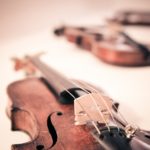The word “orchestra” comes from a Greek word (“orcheisthai“) that means “to dance.” When the ancient Greeks built their theaters, they would leave a place in front of the stage for dancers and the chorus to appear in the performances. This area in front of the stage was called “the orchestra,” which meant “the place in front of the stage where the dancers dance.”
As musicians were added to spice up the shows in theaters, the musicians were put– where else? — in “the orchestra” (that is, the space directly in front of the stage). Over time, this location also became what the group of musicians were called. (Sometimes when you go to a concert or a theater you can buy “orchestra seats,” which doesn’t mean seats in the orchestra, it means the seats that are below the level of the stage.)
An orchestra is made up of lots of different musical instruments. It makes it easier if you divide them up into “families” of instruments. These are:
the strings
the woodwinds
the brass, and
the percussion
- String
- Woodwind
- Brass
- Percussion
The String Orchestra
A “string orchestra” is made up of only string instruments, with no woodwinds, brass, or percussion.
Four major kinds of instruments make up the string orchestra. These are, from the smallest to the largest in size:
the violin
the viola
the cello, and
the double bass
A typical string orchestra can contain anywhere from eight instruments on up. This type of orchestra plays special compositions written exclusively for these four instruments. Many of the pieces that were composed for string orchestra were written during two specific periods of musical history: the Baroque Era (1600-1750) and the Classical Era (1750-1820).
The smaller instruments (the violin and viola) produce higher-pitched sounds, and are carried on a musician’s left shoulder, with the left side of the jaw resting on the chinrest. The jaw and the shoulder must hold the violin firmly enough to stabilize it while the right hand handles the bow.
The larger instruments (the cello and double bass) produce low, rich sounds. The cello is played while its player is seated, with the instrument supported on the floor. The double bass, even larger than the cello, is most often played with the musician standing up, although it can also be played while seated on a tall stool.
All four of these instruments are all shaped in a similar manner, with curvy wooden bodies and wooden necks. The strings stretch over the body and neck and attach to small heads, where they are tuned with tuning pegs.
These string instruments play a very important role, making up about 2/3 of a full symphony orchestra. Many famous works of the past few centuries have been written for performance by string instruments and string orchestras.






